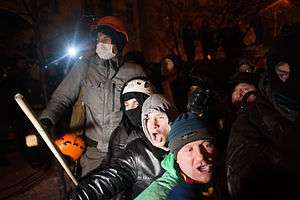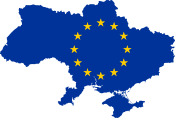11 December 2013 Euromaidan assault
| 11 December 2013 police assault on Euromaidan | |||
|---|---|---|---|
| Part of Euromaidan | |||
 Police clash with protesters on the night of 10 December | |||
| Date | 10–12 December 2013 | ||
| Location | Kiev, Ukraine | ||
| Causes | Police attempt to clear Maidan | ||
| Goals | To clear Maidan | ||
| Methods | Protesting, raiding, civil disobedience | ||
| Status | Over | ||
| Parties to the civil conflict | |||
| |||
| Lead figures | |||
| |||
| Casualties | |||
| |||
The assault of Euromaidan by security forces on 11 December 2013 was an attempt of Viktor Yanukovych’s regime to wind up Euromaidan by means of a night assault using Berkut special police units and soldiers of internal troops. Their tactics were the displacement of frontal peaceful protesters from slightly barricaded camps at the Independence Square and the part of Khreshchatyk Street towards the Bessarabska Square. The grounds for the assault were the requirements of public enforcement that arrived at the site and read out the resolution of the Pecherskyi District Court. It was found later that such a procedure was illegal, as the public enforcement has the right to read out such demands only by 10 pm. In fact, the court’s decision only had to do with the fact that Vitali Klitschko was forbidden to hinder citizens moving along the main streets. Vitali Klitschko himself was neither informed of that resolution nor given the opportunity to appeal against it.[1] People responsible for the unlawful assault against peaceful protesters have not been identified.
Events
Start of the assault
The Berkut special police units began to clear up Euromaidan. At 1:02 am Berkut began to break down the barricades in Instytutska street, while starting the fight with "Freedom" party deputies Ruslan Koshulynskyi, Oleksii Kaida, Andrii Mishchenko and Oleh Osuhovskyi. Two of them were injured over face and body. At 1:33 a.m. Andriy Shevchenko informed that Berkut forces were going to break the barricades from the side of Mykhailivska Square.[1][2] Violent fights occurred in the Square. Berkut were destroying the barricade in Instytutska street, and titushky started plundering the camp. Although the government concentrated a large number of security forces around the square, protesters did not give up and their number was growing. Berkut sprayed gas, the clouds of tear gas were visible over the crowd and messages about arrested and injured people, including MPs, were being reported. Calls for mass mobilization of Kyiv citizens to the Maidan were spread.[3]
End
Berkut suspended the assault and protesters were giving Berkut the shields, obtained from them. Berkut began to regroup. Unarmed people had been holding the Euromaidan defense line for three hours against the large mass of Berkut from the Instytutska street side of the square.[4] The number of people at Euromaidan grew, but the leaders of Berkut were also trying to regroup forces in order to attack from the other side. Several titushky (thugs) sprang out from the Prorizna street and started to attack people aiming to organize a hash.[5] There were more than 15 thousand people on the Maidan. The Berkut were still trying to break into the trade union building. The number of people on the Maidan was increasing. Berkut came closer to the Maidan and tried to encircle it.[5]
Bells of the Maidan
As the 4,000 Berkut attacked the square, the bell-ringer of the St. Michael's Golden-Domed Monastery rang the alarm. 8 hours after the assault had begun, self-defense units stabilized the Euromaidan perimeter by pushing the Berkut fighters back beyond the barricades.[6]
Consequences
The force assault of peaceful protesters led to the following consequences:
- The bells of St. Michael's Golden-Domed Cathedral were giving alarm the whole night, as if it was in the Middle Ages, and that allowed the protesters to get reinforcements.
- The warning alarm system of the National resistance headquarter enabled a lot of activists to come by cars or passing transport (taxi drivers gave a free ride) and prevent the assault of security forces .
- The illegal court order was not executed. The government didn’t try to execute it any more.
- The protesters’ tents smashed by security forces were restored after a few hours .
- Protesters replaced destroyed light barricades were with firm and complicated ones. What was established: a few lines of barricades; barricades were made multistaged; simple and complicated antipersonnel fence ("hedgehogs " with barbed wire); barrels were placed; snow and ice were collected into bags and stacked to the height of 2.3 meters; armature, boards, metal fences and mesh - netting were applied.
- The number of barricades around the Euromaidan perimeter was increased in the places where none of them were before (Prorizna street, Horodetskyi street, the stairs descend from the October Palace).
- The organization of self-defence was improved and the defense teams at the entrances to Euromaidan were reinforced.
- The supervisory positions were arranged by the town major’s office in tents at all entrances to Kyiv.
- Some detachments of delf-defence were given self-made (of human-height) and small plastic shields.
References
| Wikimedia Commons has media related to Euromaidan in Kiev: December 11, 2013. |
- 1 2 "СИЛОВИКИ ПРОРВАЛИСЯ НА МАЙДАН".
- ↑ СИЛОВИКИ ПРОРВАЛИСЯ НА МАЙДАН Українська Правда, 11 грудня 2013 р.
- ↑ "ШТУРМ БАРИКАД. 11 грудня. НІЧ ТА РАНОК СПРОТИВУ - Українська правда". Українська правда. Retrieved 23 October 2014.
- ↑ "Аронець live (Svoye.TV)". Ustream. Retrieved 23 October 2014.
- 1 2 "Головна сторінка". Retrieved 23 October 2014.
- ↑ "Церква засудила дії правоохоронців в ніч на середу на Майдані". Радіо Свобода. Retrieved 23 October 2014.
